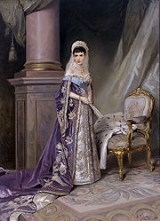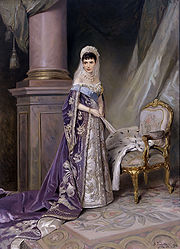
Vladimir Makovsky
Encyclopedia
Vladimir Yegorovich Makovsky 1846, Moscow - 21 February 1920, Petrograd) was a Russia
n painter, art collector, and teacher.
 Makovsky was the son of collector, Yegor Ivanovich Makovsky, who was one of the founders of the Moscow Art School. Vladimir had two brothers, Nikolai Makovsky and Konstantin Makovsky
Makovsky was the son of collector, Yegor Ivanovich Makovsky, who was one of the founders of the Moscow Art School. Vladimir had two brothers, Nikolai Makovsky and Konstantin Makovsky
, and one sister, Alexandra Makovsky, all of whom were famous painters. Vladimir studied at the Moscow School of Painting, Sculpture, and Architecture. He finished his studies in 1869 and the following year became one of the founding members of the Association of Travelling Art Exhibitions, where his many years of prolific work brought him to a leading position
Makovsky's work was defined by a perpetual humor as well as blatant irony and scorn. During the seventies his paintings dealt primarily with small-town folk. His pictures, "The Grape-juice Seller" (1879), "Fruit-Preserving" (1876) and "The Congratulator" (1878) depict various scenes where the mood is finely conceived and almost laughter-inducing. Other works of his, such as "The Benefactor" (1874) and "The Convict" (1878) are profoundly socially-conscious. In them, Makovsky either criticizes the false sympathy of the aristocracy towards the poor, or draws attention to the oppression and persecution by the tsarist gendarmerie. In 1878, he became an academician.
In the eighties, during the time of Russian "democratic" painting, Makovsky produced some of his most valued works. In 1882, he was made professor at the Moscow Art School after the death of Vasili Perov. Some of Makovsky's greatest works of this period include "In the Ante-room
of the Court of Conciliation" (1880), "The Released Prisoner" (1882), and "The Collapse of the Bank" (1881). From the end of the 1880s, Makovsky began to produce more gloomy works. Quintessential works of this period include "You Shall Not Go" (1892), and "On the Boulevard" (1888).
In 1894, Makovsky became Rector of the Preparatory school of the Academy of Art. After the First Russian Revolution, he painted "January 9, 1905, on Vasilyev Island" in which he depicts the armed police firing at defenseless people. In another painting "The Sacrifices on the Khodyn Field" in which a thousand people lost their lives during the coronation ceremony in 1896 of Nicholas II, he again stood uncompromisingly on the side of the oppressed people. After the 1917 October Revolution, Makovsky helped carry over the realist traditions to the early stages of Socialist Realism
.
Russia
Russia or , officially known as both Russia and the Russian Federation , is a country in northern Eurasia. It is a federal semi-presidential republic, comprising 83 federal subjects...
n painter, art collector, and teacher.

Konstantin Makovsky
Konstantin Yegorovich Makovsky was an influential Russian painter, affiliated with the "Peredvizhniki ". Many of his historical paintings, such as The Russian Bride's Attire , showed an idealized view of Russian life of prior centuries...
, and one sister, Alexandra Makovsky, all of whom were famous painters. Vladimir studied at the Moscow School of Painting, Sculpture, and Architecture. He finished his studies in 1869 and the following year became one of the founding members of the Association of Travelling Art Exhibitions, where his many years of prolific work brought him to a leading position
Makovsky's work was defined by a perpetual humor as well as blatant irony and scorn. During the seventies his paintings dealt primarily with small-town folk. His pictures, "The Grape-juice Seller" (1879), "Fruit-Preserving" (1876) and "The Congratulator" (1878) depict various scenes where the mood is finely conceived and almost laughter-inducing. Other works of his, such as "The Benefactor" (1874) and "The Convict" (1878) are profoundly socially-conscious. In them, Makovsky either criticizes the false sympathy of the aristocracy towards the poor, or draws attention to the oppression and persecution by the tsarist gendarmerie. In 1878, he became an academician.
In the eighties, during the time of Russian "democratic" painting, Makovsky produced some of his most valued works. In 1882, he was made professor at the Moscow Art School after the death of Vasili Perov. Some of Makovsky's greatest works of this period include "In the Ante-room
Antechamber
An antechamber is a smaller room or vestibule serving as an entryway into a larger one. The word is formed of the Latin ante camera, meaning "room before"....
of the Court of Conciliation" (1880), "The Released Prisoner" (1882), and "The Collapse of the Bank" (1881). From the end of the 1880s, Makovsky began to produce more gloomy works. Quintessential works of this period include "You Shall Not Go" (1892), and "On the Boulevard" (1888).
In 1894, Makovsky became Rector of the Preparatory school of the Academy of Art. After the First Russian Revolution, he painted "January 9, 1905, on Vasilyev Island" in which he depicts the armed police firing at defenseless people. In another painting "The Sacrifices on the Khodyn Field" in which a thousand people lost their lives during the coronation ceremony in 1896 of Nicholas II, he again stood uncompromisingly on the side of the oppressed people. After the 1917 October Revolution, Makovsky helped carry over the realist traditions to the early stages of Socialist Realism
Socialist realism
Socialist realism is a style of realistic art which was developed in the Soviet Union and became a dominant style in other communist countries. Socialist realism is a teleologically-oriented style having its purpose the furtherance of the goals of socialism and communism...
.

